In the world of luxury, watch brands fall over themselves to offer their customers something special. At the top end of the scale is the unique piece watch that has been designed specifically for a single customer. But for the average collector such a watch will forever be the stuff of dreams. So how can watch brands nevertheless tempt their customers with a hint of the unique in their watches? Smart brands have understood that carbon fibre composites are an effective way to do this, particularly with the latest types of composites, and some have even gone as far as to develop their own carbon composites. Because of the way such composites are produced (layers of fibre sheets are positioned at different angles to improve the robustness of the finished material), there is a lot of flexibility in which particular types of carbon can be used, how the layers can be arranged and which polymers and resins can be used to bind them. Most important for the watch industry is the fact that when the case is machined from a solid block of the material it reveals the structure of the material in a finish that is unique to every watch case.
Carbon fibre lends itself to watch cases for other reasons, however. It is three times stiffer than titanium yet weighs two times less than the metal. Most men to whom the virile black of such cases appeals will already be familiar with the material from various other areas, such as Formula 1 and yacht racing, or they may even have composites in some of their other possessions like tennis racquets, golf clubs or fishing rods. For the same reasons, carbon fibre watches are designed almost exclusively with men in mind and invariably keep the black colour of the composite, with a matte or sometimes glossy finish. Although some of the innovative materials listed below allow brands to add different colours to the mix, including the luxury sheen of gold.
The only downside to carbon fibre as far as watch cases are concerned is that, because it is much more robust than other materials, it is also much more difficult to machine. The milling process takes longer and the tools in CNC machines used to mill the parts wear out much quicker and have to be reset much more often. This can mean a big difference in price of carbon fibre watches compared with those in metals such as steel or titanium. As watch collectors know only too well, luxury has its price.
The first applications of carbon fibre in watchmaking were purely for the case, but brands soon extended the use of the composite to other components on the watch. Bell & Ross, for example, offers its iconic BR 01-92 model with a square case and a matching black dial in carbon fibre.
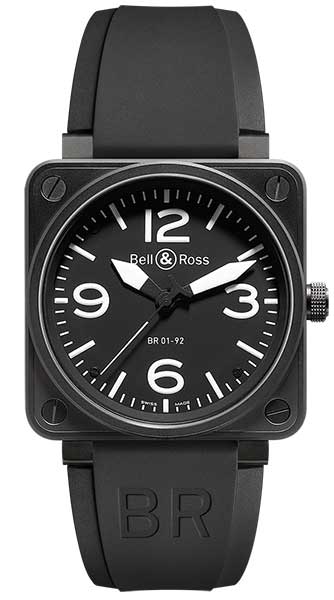
Bulgari went one further with the top of the range piece in its Octo Finissimo collection, presenting the world’s thinnest minute repeater in a watch with a carbon case, carbon dial and even a carbon fibre bracelet.

Despite the difficulty in machining it, carbon fibre has even made its way into mechanical watch movements, where tolerances are measured in microns and function and aesthetics go hand-in-hand. The first watch born of the partnership between Richard Mille and McLaren, for example, the RM 50-03, has a movement that weighs just seven grammes. The baseplate and some of the bridges are made out of grade 5 titanium but other bridges are made from CarbonTPTTM (see below). The entire movement is supported by a special carriage made of the same material that is attached directly to the caseband.
Roger Dubuis used carbon fibre composites for a number of pieces of its Excalibur Spider Carbon movement, which was presented in 2017, including the main plate, bridges and even the upper part of the tourbillon cage. The result is a structure on the movement that matches that on the case. But the use of composites inside the movement poses an additional challenge for Roger Dubuis, since the brand certifies the majority of its watches with the Geneva Hallmark. The requirements of this certification impose strict conditions on the decoration of movement components, including hand finishing. Carbon fibre composites are difficult enough to work by machine, so the hand finishing of each piece adds an extra layer of complexity to this 180,000 Swiss franc watch.
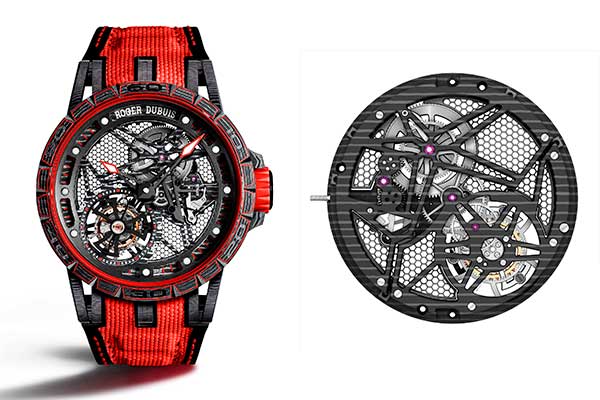
But what exactly is carbon fibre and how is it used in watch cases? Carbon fibres alone are little use until they are woven together (and the more complex the weave, the more resistant the composite) then bound with a plastic polymer by heat or pressure to form a composite. There is now a big choice of watches on the market, using many different types of carbon fibre. Below we list some of the main types of carbon composites used in the watch industry.
Forged carbon composite
Forged carbon composite dates back to the mid-2000s and was developed in an unlikely partnership between Lamborghini (which was looking to reduce the cost of composite components), Callaway Golf Company and the University of Washington. Whereas carbon fibre is produced by infusing layers of sheets with resin, forged composite starts with a sheet of uncured plastic, to which short and randomly arranged carbon fibre strands are added. This can then be added to a resin to form a paste that can be placed into a mould. Once squeezed and heated under pressure in the mould, the finished product emerges in the shape required.
Audemars Piguet was one of the first watch brands to use forged carbon in a watch case in 2007, on a special edition of the Royal Oak Offshore for men in the colours of the Swiss America’s Cup team Alinghi. Since then it has been adopted by a number of other watch brands for regular collections as well as customised watches. Bamford Watch Department, for example, collaborated with TAG Heuer to produce the TAG Heuer Monaco Bamford, a version of the legendary Monaco chronograph in their signature black colour with a forged carbon case. TAG Heuer also offers a number of carbon-cased watches in the Carrera and Aquaracer collections.
Carbonium®
Carbonium® is a new generation of material from the French aerospace sector. It is composed of two thirds intermediate modulus carbon fibre and one third high-temperature epoxy that gives it a totally unique aesthetic. Carbonium® is composed of the aeronautical grade carbon fibre used to make vital structural parts of modern aircraft. It is roughly twice as light as aluminium and twice as environmentally friendly as conventional carbon composites because it is not made of virgin materials: 95% of it is sourced from carbon by-products in the aeronautical cycle. This makes a big difference in its sustainability. The innovative process used to up-cycle this aerospace-grade carbon material is based on three patents held by the French start-up Lavoisier Composites.
More important for watch industry applications is that Carbonium® is aesthetically appealing. Its manufacture involves high pressures and temperatures that reveal the organic pattern created by carbon fibres. It can also be combined with other metals and pigments. Carbonium® Gold, for example, is a “fusion” of 7-micron carbon filaments and dispersed gold particles within a thermosetting matrix.
Carbonium® made its debut in the Ulysse Nardin X collection for men that was presented in 2019.
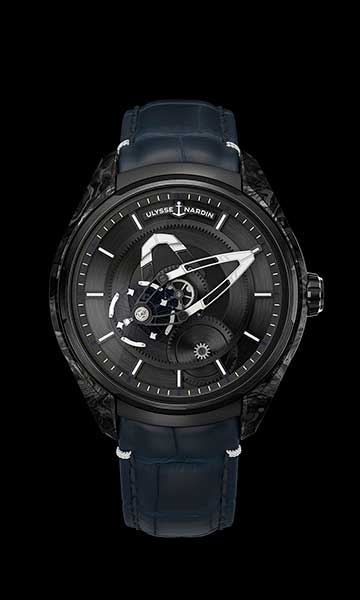
CarbotechTM
Carbotech is a composite material based on carbon fibre. As well as providing exceptional technical performance, Carbotech has an uneven, matt black appearance, which varies according to the way in which the material is cut. To form plates of Carbotech for machining, thin sheets of carbon fibre are compressed at a controlled temperature under high pressure together with a high-end and robust polymer, PEEK (Polyether Ether Ketone), which binds the composite material, making it even stronger.
Officine Panerai was the first watch brand to use this material in a watch case in the limited-edition Luminor Submersible 1950 CarbotechTM for men, which was presented in 2015. Officine Panerai owns the trademark for this particular carbon composite.
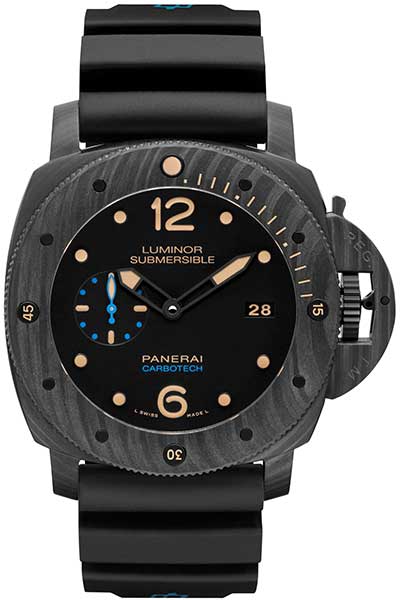
Carbon glass
Also known as glass-like carbon, carbon glass is a form of pure carbon with excellent resistance. No other carbon manufacturing techniques match the level of airtightness of that are used in the manufacture of carbon glass. The big difference with carbon glass is that it is 100 times more robust than steel, yet has a density close to 1, meaning that it will actually float in water.
From an aesthetic perspective, carbon glass – unlike other carbon composites – has a smooth and uniform surface on all sides. The use of coloured glass fibres in the manufacturing process can add touches of colour to the material for watch cases.
Girard-Perregaux introduced carbon glass into its collection in 2019. Its theme for the year was “Earth to Sky”, with watches in combinations of black and blue making a big impact throughout the collection. Carbon glass with blue glass fibre was used for a special-edition of the Laureato Absolute Chronograph for men.
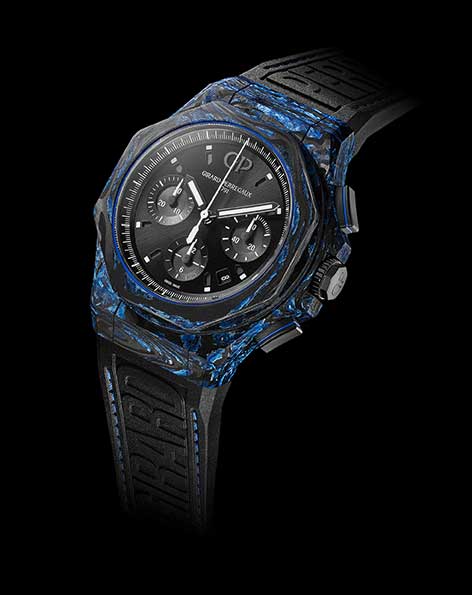
NTPTTM Carbon
NTPTTM Carbon is made by curing extremely thin (30 micron) layers of carbon fibre that have been turned successively by 45 degrees in relation to the layer below. When the material is machined from a solid block, it produces a distinctive pattern that differs from the woven look of carbon fibre or the more coherent look of forged carbon.
The use of this composite signalled the start of a collaboration between Richard Mille and North Thin Ply Technologies, based in Renens, Switzerland. As well as providing components for demanding high-tech sports like Formula 1 and yacht racing, the company last year opened a new dedicated workshop for Richard Mille to supply all high-tech materials used in the brand’s watches, including TPT® Quartz, the world's first thin ply quartz fibre prepreg, which made its debut in the RM 27-02 Rafael Nadal edition in 2015.
GraphTPTTM
GraphTPTTM is the result of joint work between the University of Manchester, McLaren Applied Technologies and North Thin Ply Technology (NTPT®). This new material is an evolution of the Carbon TPTTM already used by Richard Mille, since the 600 layers, each just 30 microns thick, that make up the composite have been impregnated with a resin containing graphene. GraphTPTTM was first seen in the Richard Mielle RM 50-03 McLaren F1 watch, a split-seconds chronograph tourbillon that weighs less than 40 grammes (including the strap), making it the lightest one ever made.

The one that got away?
Carbotanium is a patented composite material invented by Modena Design, the carbon composite manufacturing and consultancy arm of the Italian car company Pagani, which used it on its Zonda R and Huayra models. As the name suggests, the components of Carbotanium are carbon fibre and titanium. They are woven together to form a strong, lightweight material that can withstand significant amounts of heat and strain. Carbon fibre has the highest strength-to-density ratio of any currently available fibre and titanium has the highest strength-to-density ratio of any currently available metal. Combining the two naturally doubles the benefits. But Pagani does not have a watch partnership and the material has yet to find its way into a watch case.
The ecological downside of carbon fibre watches
Carbonium® may well be more sustainable than other forms of carbon fibre composite, since it is “upcycled” from waste products from other applications. But recycling carbon fibre itself is very difficult. The only available method for complete recycling is a process called thermal depolymerisation, which involves heating the product in an oxygen-free chamber. The carbon is released and can be reused, while the bonding materials are burned away. Carbon fibre can also be broken down manually at lower temperatures, but this shortens the fibres and thus weakens the material. So bigger carbon fibre products may well be broken down for use in smaller ones, such as watches, but recycling the carbon in the watches themselves will not be so easy.











